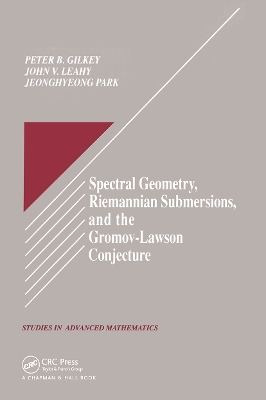Studies in Advanced Mathematics
1 primary work
Book 30
Spectral Geometry, Riemannian Submersions, and the Gromov-Lawson Conjecture
by P. B. Gilkey, John V. Leahy, and Jeonghyeong Park
This cutting-edge, standard-setting text explores the spectral geometry of Riemannian submersions. Working for the most part with the form valued Laplacian in the class of smooth compact manifolds without boundary, the authors study the relationship-if any-between the spectrum of Dp on Y and Dp on Z, given that Dp is the p form valued Laplacian and pi: Z (R) Y is a Riemannian submersion.
After providing the necessary background, including basic differential geometry and a discussion of Laplace type operators, the authors address rigidity theorems. They establish conditions that ensure that the pull back of every eigenform on Y is an eigenform on Z so the eigenvalues do not change, then show that if a single eigensection is preserved, the eigenvalues do not change for the scalar or Bochner Laplacians. For the form valued Laplacian, they show that if an eigenform is preserved, then the corresponding eigenvalue can only increase. They generalize these results to the complex setting as well. However, the spinor setting is quite different. For a manifold with non-trivial boundary and imposed Neumann boundary conditions, the result is surprising-the eigenvalues can change.
Although this is a relatively rare phenomenon, the authors give examples-a circle bundle or, more generally, a principal bundle with structure group G where the first cohomology group H1(G;R) is non trivial. They show similar results in the complex setting, show that eigenvalues can decrease in the spinor setting, and offer a list of unsolved problems in this area.
Moving to some related topics involving questions of positive curvature, for the first time in mathematical literature the authors establish a link between the spectral geometry of Riemannian submersions and the Gromov-Lawson conjecture.
Spectral Geometry, Riemannian Submersions, and the Gromov-Lawson Conjecture addresses a hot research area and promises to set a standard for the field. Researchers and applied mathematicians interested in mathematical physics and relativity will find this work both fascinating and important.
